
The Leidolf company was founded in Wetzlar (of Leica fame!) in 1921 by Rudolf Leidolf. Amongst others, it produced lenses for microscopes. After WWII, like many others, Leidolf recognised the demand for cameras and started to get involved in camera manufacture. The first camera was the 1950 Leidox. It produced several relatively simple cameras until it came out with the Lordomat range of cameras with coupled rangefinders and/or interchangeable lens mounts. Lenses were apparently made by Enna-Werk Munchen according Leidolf designs. Camera production ended in 1962 but the Leidolf company survived in different form until it was taken over by Leica in 1990.
Leidox
The 1950 Leidox was the first camera produced by Leidox. It made 4x4cm negatives on 127 rollfilm. It had a simple Galilean viewfinder and a 50mm f/3.8 Triplet lens in a Vario shutter. To load film one would slide down the camera back after twisting the strap lugs, which doubled as locking nuts, by 90 degrees. Due to the simplicity of roll film, needing no wind lock or rewind knob, the camera itself was rather minimalistic. It was covered with brittle plastic with a fibrous sheen.
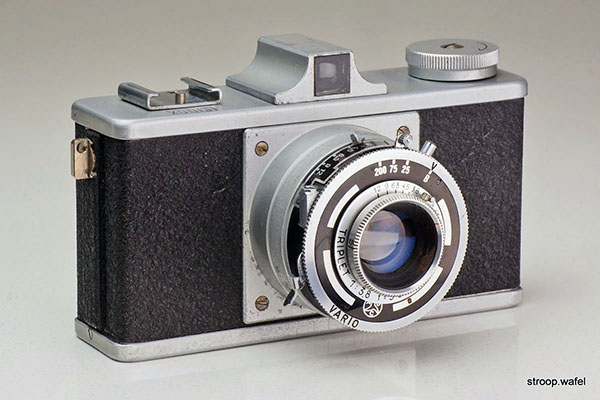
A Leidolf Leidox camera. These cameras were a little hard to service as it is difficult to get to the shutter without a specialist tool to remove the middle lens element, and the top plate is impossible to remove.
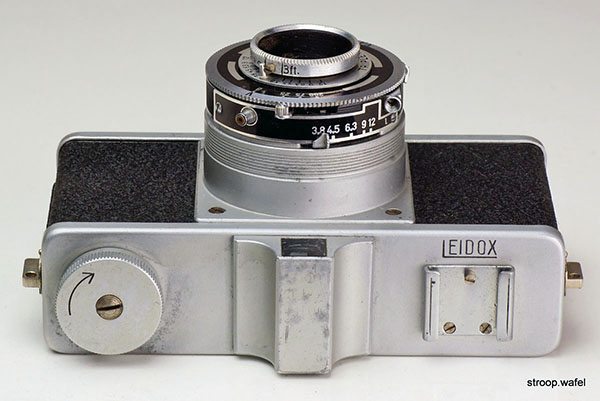
Top view of the Leidox, less is more!
Lordox IIS
The Lordox IIS was a step up from the Leidox, as it had a body-mounted shutter release and double exposure lock. The plated top housing had a more elegant design and the camera had a faster f/2.8 Triplon lens in a Prontor-S shutter, although a version with f/3.8 Triplet and Vario shutter was also still available (the Lordox I). Film and film loading were still the same as on the Leidox.
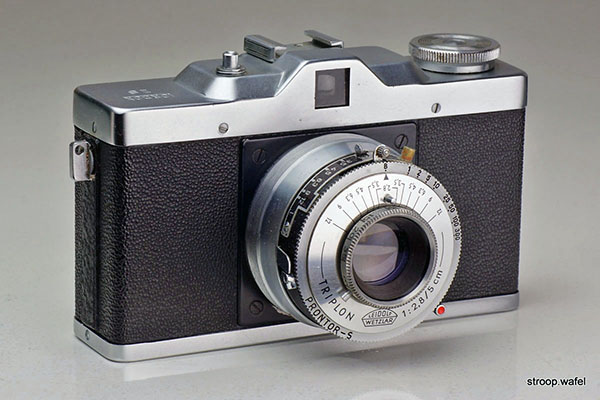
A Lordox IIS. Apart from the changes described above, also the plastic covering differed from that on the Leidox.
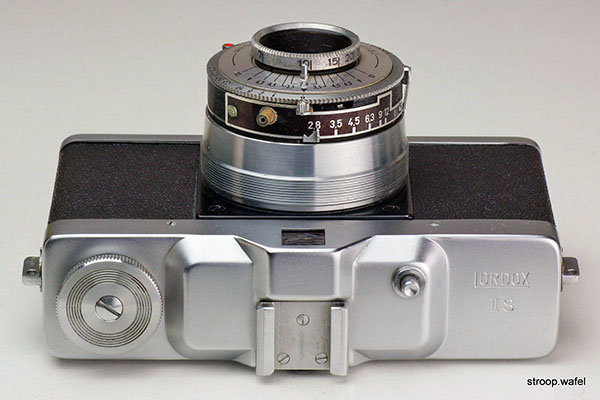
Top view of Lordox IIS.
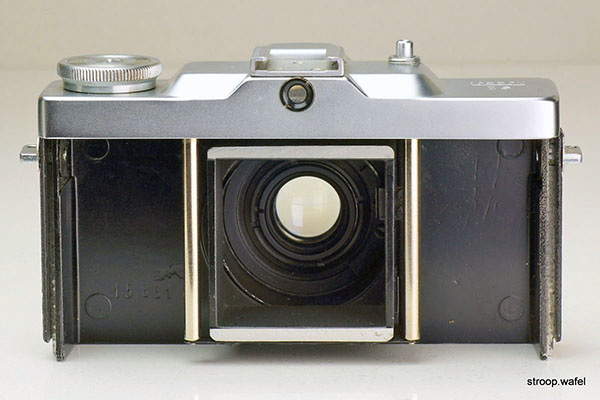
Rear view of Lordox IIS after removing the back (note the twisted strap lugs) and with the shutter firing. A serial number (15 831) in stamped on the inside. It can easily be seen why a company just starting out building cameras would decide to build a roll film camera!
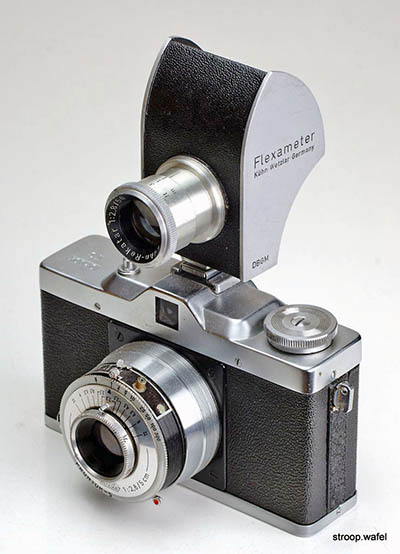
What is this? A Leidolf TLR camera? No, it a Lordox with Kuhn Flexameter attached. This unusual accessory was a waist-level finder which one could use to focus viewfinder cameras without rangefinder. Allegedly this accessory was designed to be used with the viewfinder Leicas by one of the Leitz family members, Elsie Leitz, and her husband Kurt Kuhn. Of course it would fit any camera with accessory shoe, including this other camera from Wetzlar. The Flexameter was equipped with a Kuhn Rekatar 50mm f/2.8 lens.
Interestingly, Kuhn also produced a camera, the Reka, by some called a Leica copy but in fact more similar (and perhaps built by?) to the Oehler Infra. The lens on this Reka, a Rekagon, was produced by Wilon, another Wetzlar company. The photographic industry in Wetzlar certainly got on!
Lordox 24x36
The 1952 Lordox 24x36 was Leidolf's first standard 135 film camera. The design was still very similar to the Lordox IIS, but out of necessity the top housing contained an additional rewind knob, a rewind lever and a frame counter. Several lenses were available, in addition to the Triplet and Triplon already found on the IIS there was a 50mm f/2.8 Lordon. It was also sold as Lordette and Optina 24x36.
If you ever want to clean the viewfinder of one of those, removing the various knobs is quite straightforward except the frame counter dial. But there is a trick: inside the film chamber below the frame counter there is a small hole, through which you can stick a pin. There is a small gear in the top housing beneath the frame counter which also has a hole in it, you need to align it with the hole in the film chamber and then block it with a pin. You can then unscrew the frame counter dial; it turns CCW if I remember well, opposite the direction you'd turn it to adjust it in any case.
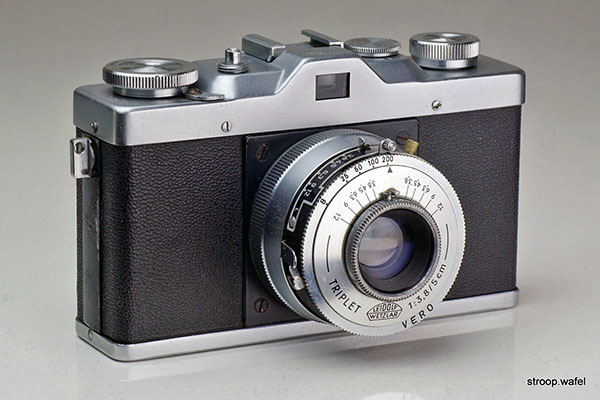
A Leidolf Lordox 24x36 with f/3.8 Triplet lens in Vero shutter. The instruction manual for this model with slower lens and simpler shutter called it the Lordox Jr. The same name would indicate non-rangefinder versions for later models.
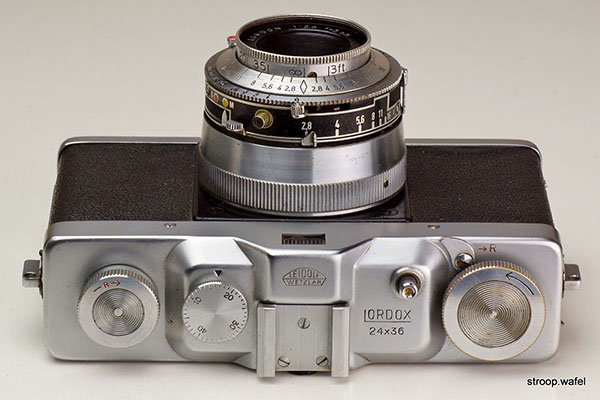
Top view of a Lordox 24x36 with the new rewind knob where the wind knob for the 127 cameras used to be, a large wind knob and new frame counter. The red spy window on the back of the camera was of course no longer present.
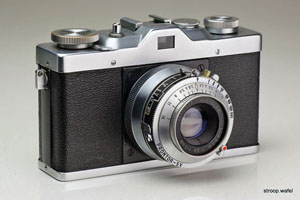
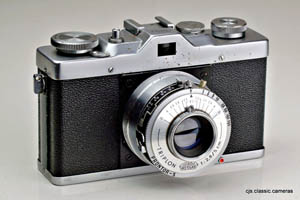
Two more variations of the Lordox 24x36, both with faster f/2.8 lenses: one a Lordon, the other a Triplon, presumably four and three-element lenses, respectively.
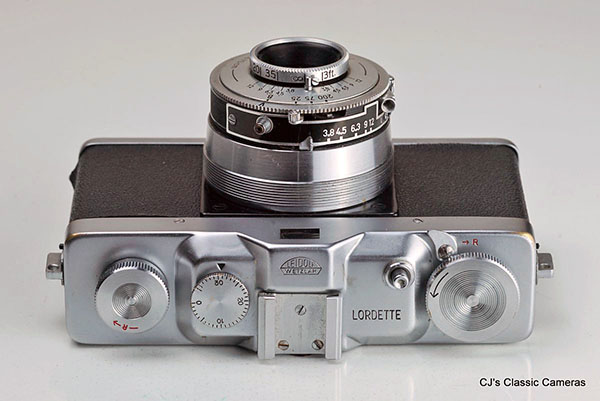
Another Lordox variant was called the Lordette, it came with Triplon 50mm f/3.8 lens in Vario shutter. As far as I am aware this model was sold in Canada only.
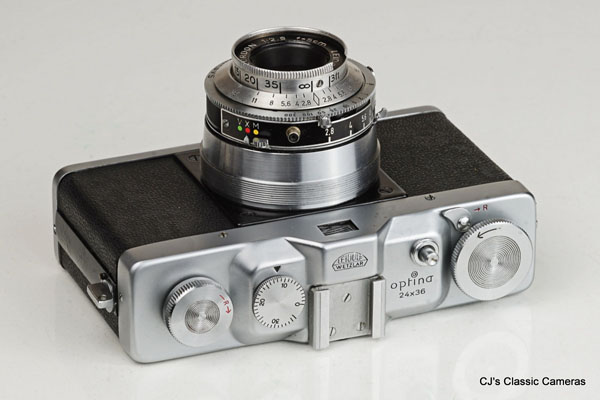
Yet another Lordox variant was the Optina 24x36, which came with Lordon 50mm f/2.8 lens in Prontor-SVS shutter. Optina was the name brand used by Eaton's in Canada, which sold many Arette cameras. The Lordox 24x36 was the only Leidolf camera sold under this name.
Lordomat
The 1954 Lordomat was a very different camera. Where simplicity ruled for the previous Leidolf products, the new camera had a wind lever, a wide-base coupled rangefinder, automatic cocking of the shutter and to top it off, an interchangeable lens mount. It was the start of a successful range of cameras of excellent build quality. A version with an added lightmeter with integrated multi-lens viewfinder built on top of the camera was the C35 (see below). The cameras were also known as Lordomat-Primus and Lordomat-Luxus, respectively.
The interchangeable lens mount was a breech lock mount with a threaded collar on the lens to tighten it to the camera, similar to the Diax and Akarette mounts. The standard lens was a four-element f/2.8 Lordonar. Available wide-angle and telelenses were mostly from Schacht-Travenar but did not have a great reputation. However, an excellent fast six-element 50mm f/1.9 Lordon made by Enna Optik was also available.
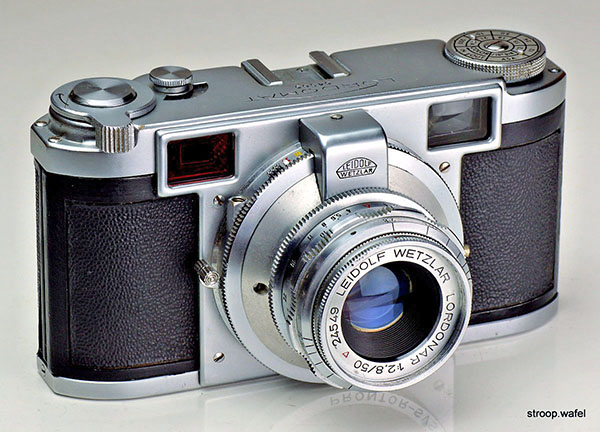
A Lordomat camera with Lordonar f/2.8 lens in Prontor-SVS shutter. The wind lever was a little unusual, it needed to be pulled towards you (like Aga Karats) in two separate strokes to transport the film and cock the shutter. Note the red rangefinder window, which perhaps was meant to make the secondary image stand out more clearly, but resulted in low contrast, especially when the subject was red!
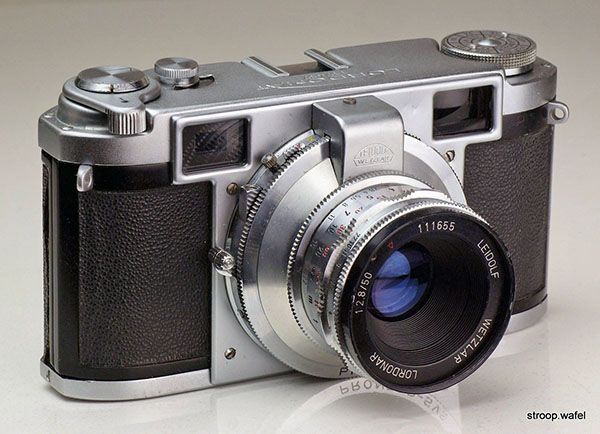
A later version of the Lordomat, which no longer had a red rangefinder window but did receive a pair of strap lugs. Otherwise it was the same as the earlier version. The Lordonar lens was also updated around this time. I think the optical formula did not change, but the front element was sat deeper in the lens body to avoid stray light from entering.
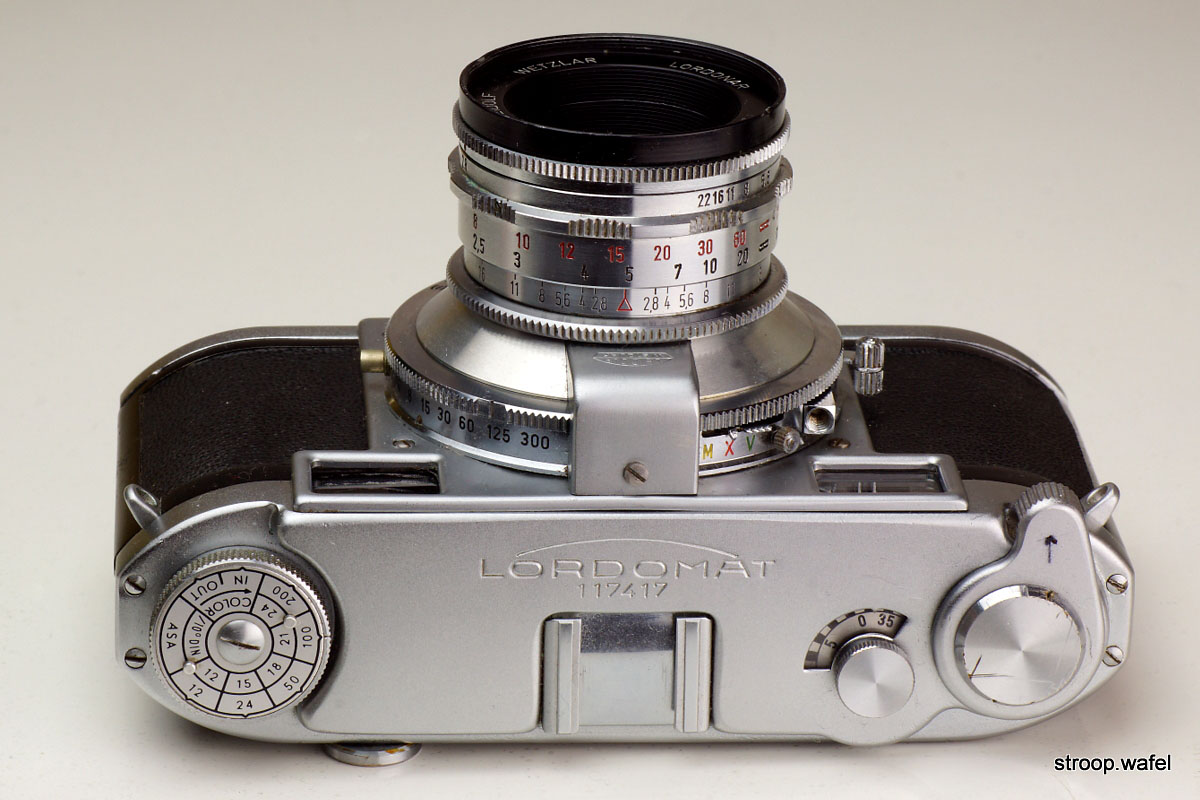
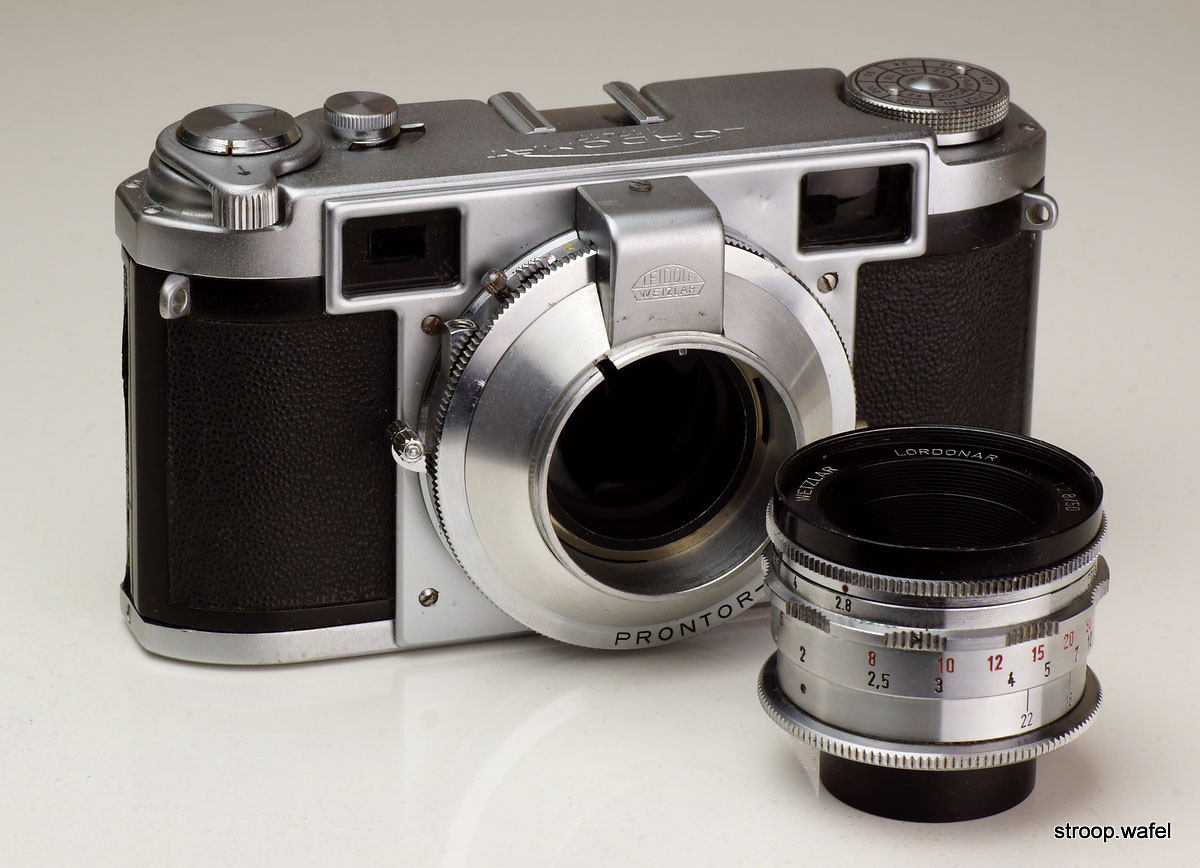
(left) Top view of the Lordomat, (right) Lordomat with the 50mm f/2.8 Lordonar lens dismounted.
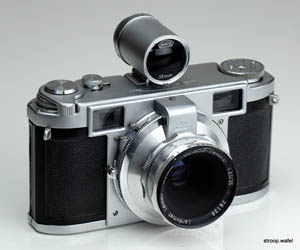
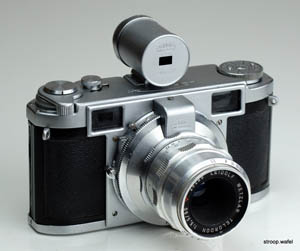
As the Lordomat viewfinder had no frame lines for lenses with different focal lengths than the standard lens, a separate 35mm viewfinder was available. It had a parallax control ring for accurate framing of close-range photographs. It also came with a mask for 90mm lenses, not the most elegant solution as the view was rather small but good enough. (left) Lordomat with 35mm f/3.5 Schacht-Travenar wide angle lens and accessory viewfinder mounted (right) Lordomat with 90mm f/5.6 Telordon lens and 90mm mask on the accessory viewfinder.
Lordomat C35
The Lordomat C35 was essentially a Lordomat with an added light meter and integrated multi-lens viewfinder added on top of the camera. The rangefinder patch was visible in the viewfinder for the standard lens, the multi-lens viewfinder showed the view for the 35mm lens as well as frames for 90mm and 135mm telelenses. It had a small dial for parallax correction but only for the two telelens frames. The light meter was manual, one could read off the shutter speed and aperture setting. It was also called the Lordox Luxus.
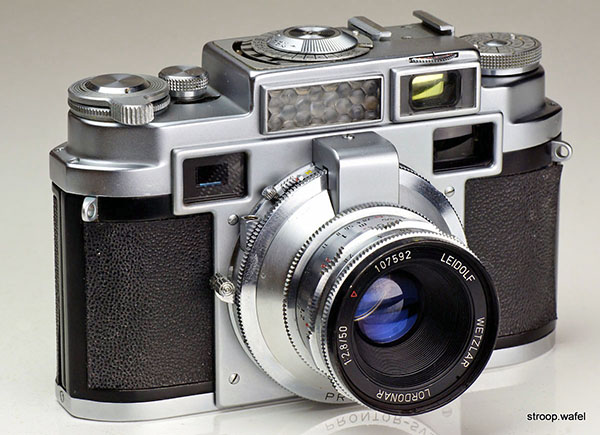
A Lordomat C35 with 50mm f/2.8 Lordonar lens. Most versions have Lordomat engraved in front of the accessory shoe and the designation C35 with the serial number at the back, but this one has neither.
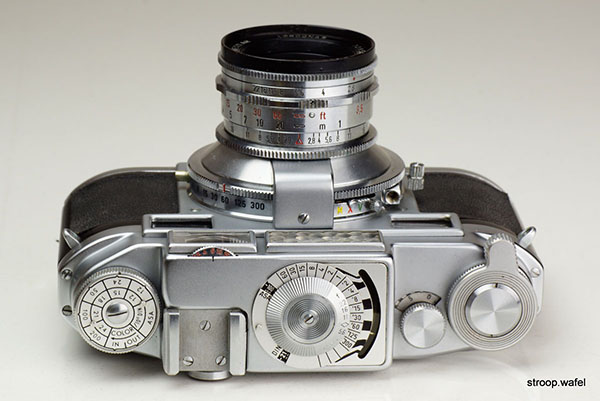
Top view of the Lordomat C35 showing the light meter and double stroke winder. The tiny parallax dial is just about visible in front of the accessory shoe.
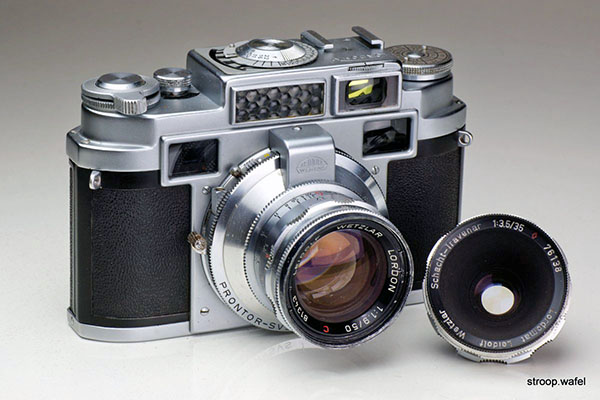
Another Lordomat C35, this one with the name engraved on the top plate. It sports the fast 50mm f/1.9 Lordon 6-element lens made by Enna Optik. Also shown is the interchangeable 35mm f/3.5 Schacht-Travenar wide angle lens.
Lordox 57 Junior/Baby/Primus
Around the same time as the Lordomat several fixed-lens versions were introduced, all with Leidolf Triplon f/2.8 lenses. These cameras were called Lordox and were essentially updated versions of the earlier Lordox 24x36 described above. Two of these were viewfinder cameras: the Lordox Baby and the Lordox Junior, which had Pronto and Prontor-SVS shutters, respectively. They generally had a black front plate, although the Baby (and perhaps the Junior) was also available in chrome. On both models one would find a Leidolf Wetzlar logo instead of a rangefinder window. A rangefinder version was also introduced, the Lordox Primus. The lens base and shutter release button were different from the Lordox Junior and Baby, it looked in fact nearly identical to the Lordomat, but had the name 'Lordox' engraved on the cover for the rangefinder linkage just above the shutter.
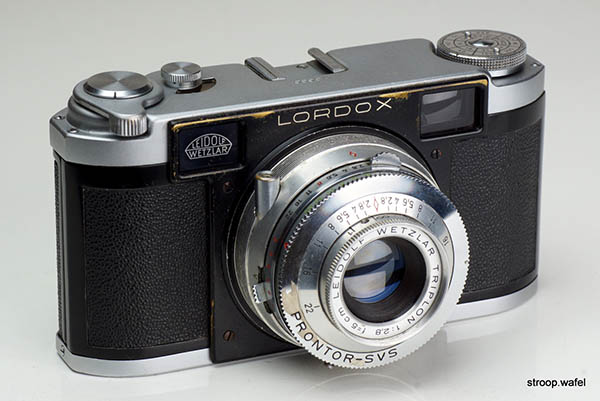
A Leidolf Lordox 57 Junior with f/2.8 Triplon lens in Prontor-SVS shutter. Note the characteristic black front plate, the only Leidolf camera to be made in this colour.
It took me a little while to figure out that the remote release socket was also the shutter release button... on most other Leidolf cameras these were separate. I think the previous owner might also have been confused, as the camera arrived with a remote release cable attached to the socket.
I have come across these models on the internet being referred to as Lordox 57, which suggests they were perhaps introduced in 1957. Other sources, however, indicate 1954 as the year of introduction, which is the same as the Lordomat. The serial numbers of all Lordox examples I have seen were similar to that of the second version of the Lordomat (with strap lugs but without red rangefinder window), which would suggest that 1957 is indeed more likely.
It is interesting to compare the prices of the different models. The simplest one, the Baby, was 69 DM, the Junior with more versatile shutter was 95 DM, and the Primus with rangefinder 128 DM. The Lordomat C35 above was no less that DM 248, but for that price you'd also get a lightmeter, interchangeable lens mount and a better lens.
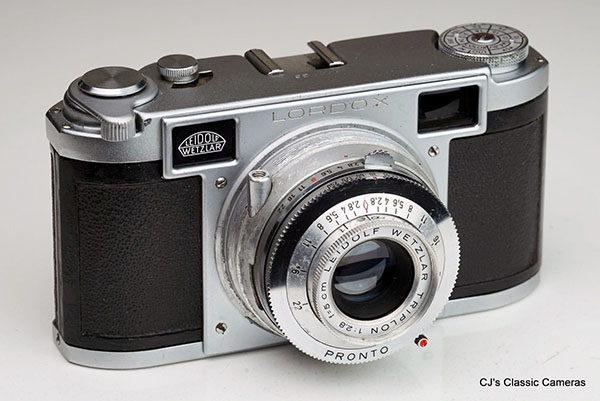
And here is the Lordox 57 Baby version with Pronto shutter, which lacks the slow shutter speed of the Prontor-SVS on the Junior. This is the version with the chrome front plate, black ones can also be found.
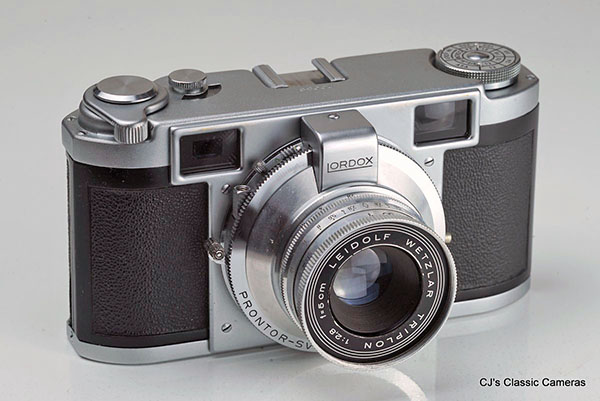
Finally, the top model: the Lordox 57 Primus with coupled rangefinder and Prontor-SVS shutter. Essentially this is a Lordomat but with a fixed lens. Personally I'd like to have seen this with a better lens, not a triplet, but Leidolf must not have deemed it worth the extra expense. I've only ever seen this model with a chrome front plate.
Adams 351
The Adams 351 was sold by US-based retailer Montgomery Ward and was essentially a rebranded Lordox 57 Baby but with an interesting twist: it had an interchangeable lens mount, like the Lordomat! The lens was a Triplon 50mm f/2.8, and buying the Adams 351 was the only way to get this Triplon as an interchangeable lens.
Advertisements for the Adams 351 specifically mentioned the existence of four interchangeable lenses, so clearly this model was designed to boost lens sales. There were a few other small differences with the Lordox 57, e.g., the Adams 351 had an old style shutter release and a seperate remote release socket.
A rangefinder version, the Adams 352, was also available and can be found below.
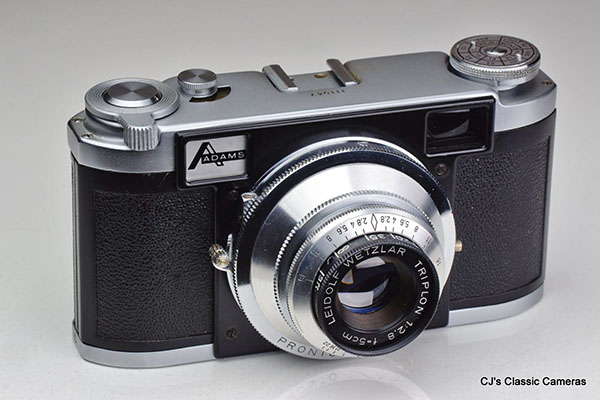
An Adams 351 with interchangeable Leidolf Triplon 50mm f/2.8 lens in Pronto shutter. This lens was not available with any other Leidolf camera.
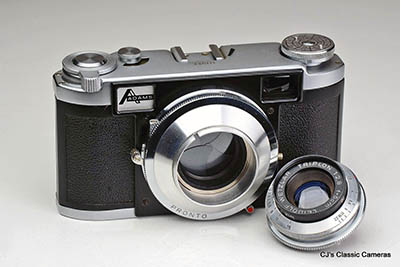
|
Same camera with the lens unmounted. Yes, you are looking at the most mundane yet rarest of interchangeable Leidolf lenses :-)
|
Adams 352
The Adams 352 was the rangefinder version of the Adams 351, more info about which can be found above. Both cameras were sold by US-based retailer Montgomery War around 1958. The Adams 352 was similar to the Lordox 57 Primus (see above), but with Pronto shutter instead of a Prontor-SVS, like the Lordox 57 Baby and a black front plate like the Lordox 57 Jr. So, like the Adams 351, the 352 was a unique model. It came with an interchangeable Lordonar 50mm f/2.8 as standard.
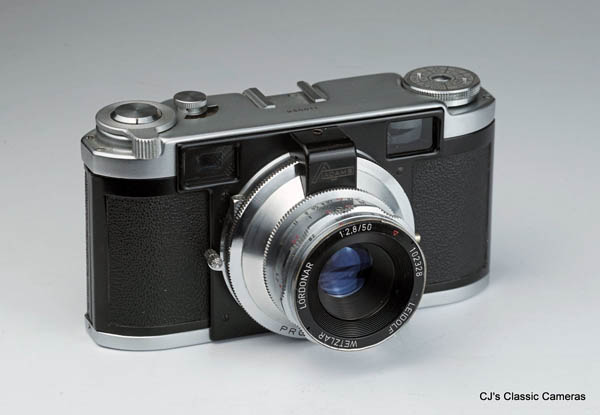
An Adams 352 with interchangeable Leidolf Lordonar 50mm f/2.8 lens in Pronto shutter. This example was kindly donated by a friend in the USA. I've never seen one for sale in Europe.
Lordomat SE
Leidolf redesigned their camera range around 1956 and introduced several new camera models. This included the Lordomat with the introduction of the new Lordomat SE. The changes were mostly cosmetic, nearly all features functioned identical to the earlier Lordomat, including the double-stroke wind lever and the frame counter knob which doubled as a rewind release knob. The main update was a brightframe viewfinder, although frames for lenses other than the standard lens were still lacking.
A version with uncoupled lightmeter, the Lordomat SLE, was also available (see below). Other models with the newly updated styling were the Lordomatic (see below), the Lordox Junior (a viewfinder only model) and Junior B (with uncoupled lightmeter).
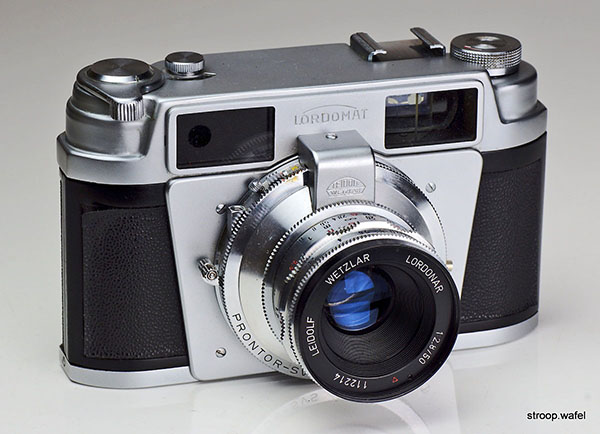
A Lordomat SE with 50mm f/2.8 Lordonar lens in Prontor-SVS shutter. This example is an early model with the same small shutter release lever as on earlier Lordomats. Later Lordomat SE production had a larger shutter release button (as one the Lordomat SLE described below).
Lordomat SLE
The Lordomat SLE was identical to the Lordomat SE above, other than the addition of an uncoupled lightmeter. The lightmeter cell was integrated with the rangefinder window, whereas the lightmeter itself was positioned on top of the camera. One could read off the shutter speed for various aperture settings and transfer these manually to lens and shutter. A nice touch was that the aperture range included the f/1.9 setting for the fast Lordon lens.
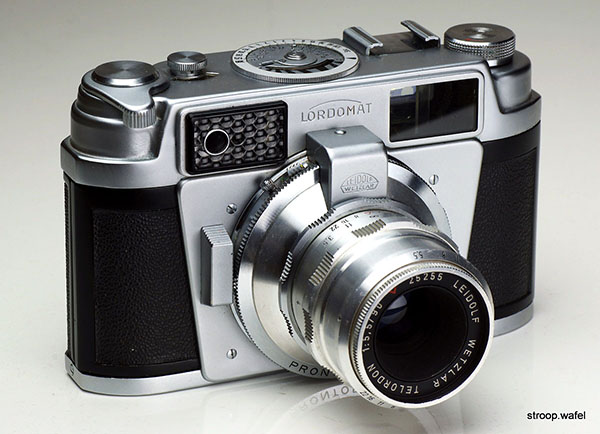
A Lordomat SLE, here with 90mm f/5.6 Telordon lens. This four-element telelens was, unlike most tele and wide-angle lenses for the Lordomat range, not made by Schacht, but probably designed by Leidolf and build by Enna Werk, like the standard lenses.
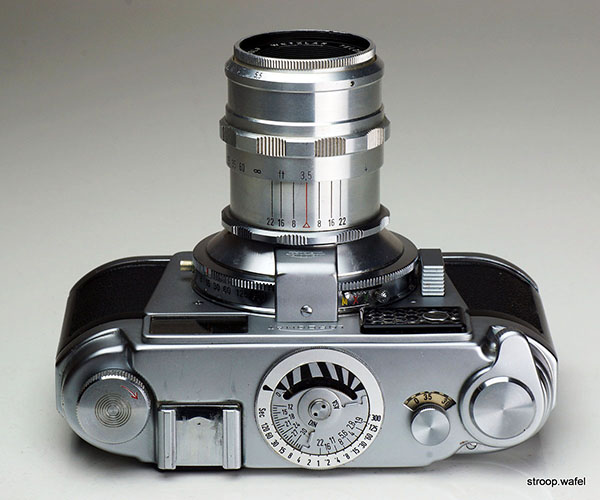
Top view of the Lordomat SLE 90mm with f/5.6 Telordon lens extended to its minimum focus distance (3.5 ft or 1 meter, same as the standard lens). It was a true portrait lens, as it allowed for a 2x magnification of the subject compared to the standard lens. Although the lens was rather slow, at the same focus distance of 1m, the depth of field at f/5.6 with a 90 mm lens was still shallower than f/2.8 with a 50 mm lens.
Lordox Junior/ Junior B
The Lordox Junior was a restyled version of the Lordox 57 Junior but did not gain any new features other than an improved frameline viewfinder. The shutter/lens assembly was in fact identical to that of the earlier version. That said, the viewfinder was a considerable improvement, which provided a bright 1:1 view with a frameline, similar in quality to the famous Leitz VIOOH acessory viewfinder. A version with uncoupled lightmeter was called the Junior B.
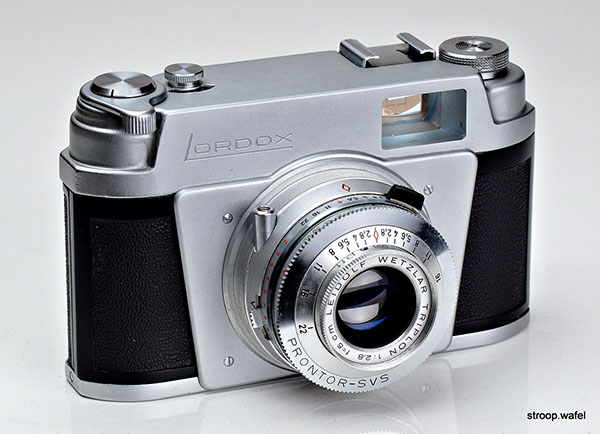
A Leidolf Lordox Junior with Leidolf Triplon 50mm f/2.8 lens in Prontor-SVS shutter.
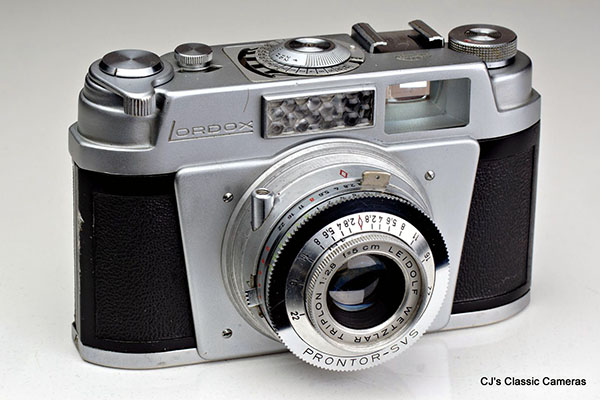
And here is the Lordox Junior B, identical to the Junior above, but with the addition of an uncoupled lightmeter in the top housing.
Lordomatic
The Lordomatic was a fixed lens viewfinder camera with coupled lightmeter. It was a fully manual camera, the name Lordomatic referring to the 'automatically' coupled lightmeter, similar to e.g., the Automatic versions of the King Regula III range, the Vitomatics and the Baldamatics. It had a brightframe viewfinder but still sported the quirky double-stroke wind lever as on earlier Lordomats. The Lordomatic was also sold as the Unimark Automatic.
A Lordomatic II also existed in at least two versions. One version had Lordomatic II indicated on the front, but it looked identical to the original Lordomatic. Another had the markings II engraved in front of its serial number at the back. This version had an updated lightmeter which was completely integrated in the top housing. The film speed therefore needed be set on the shutter.
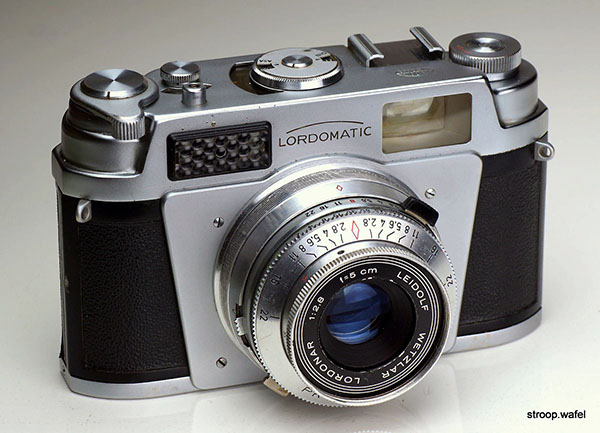
A Leidolf Lordomatic with Lordonar 50mm f/2.8 lens in Prontor-Matic shutter.
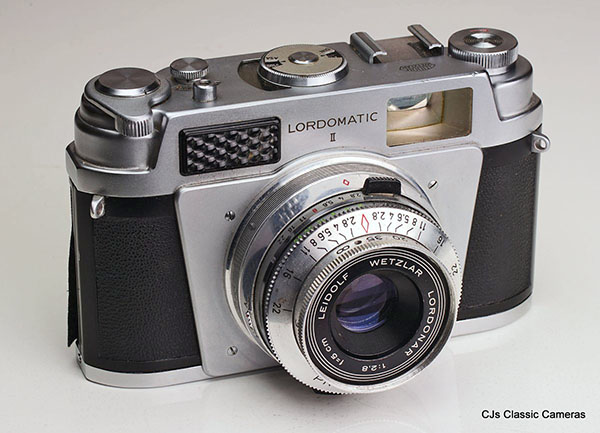
An as far as I can tell identical Lordomatic except for the 'II' below the name.
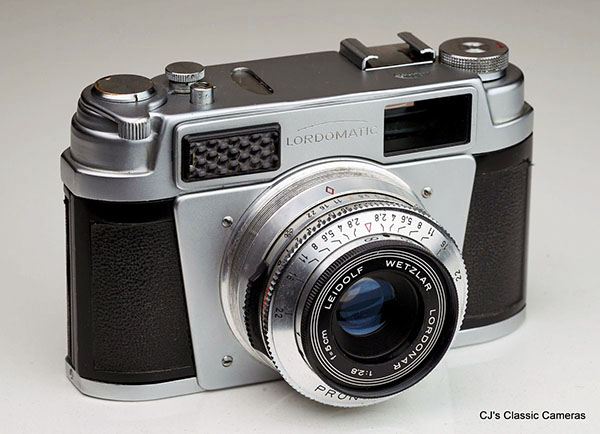
This is the later version which has an updated coupled lightmeter system with the match needle activated by turning the aperture or speed ring on the lens intself, instead of the lightmeter dial on top of the camera like on the previous versions.
Lordomatic IIR
The Lordomatic IIR was the rangefinder version of the Lordomatic II version that had a lightmeter completely integrated into the top housing (see above under Lordomatic). A small window in the top showed the lightmeter needle as well as the matching needle. The rangefinder window was located where the 'Lordomatic' logo was on other models; the logo on this model was located just below the lightmeter. It appears this was the only version of the IIR.
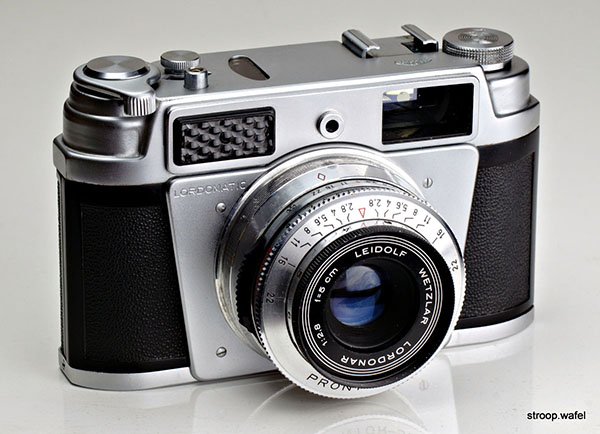
A Leidolf Lordomatic IIR with Lordonar 50mm f/2.8 lens in Prontor-SLK shutter.
Lordox (Super) Automat
Around 1960 Leidolf introduced a range of cameras with restyled bodies, including the Lordox Automat. Unlike its predecessors it had a standard single-stroke wind lever. The camera's auto-exposure system would choose the aperture setting based on measured light levels and selected shutter speed, and show the value in the viewfinder. It also had a fully manual mode. A rangefinder version was called the Super Automat. In North America the Automat and Super Automat were also sold under the name Unimatic 606 and 707, respectively.
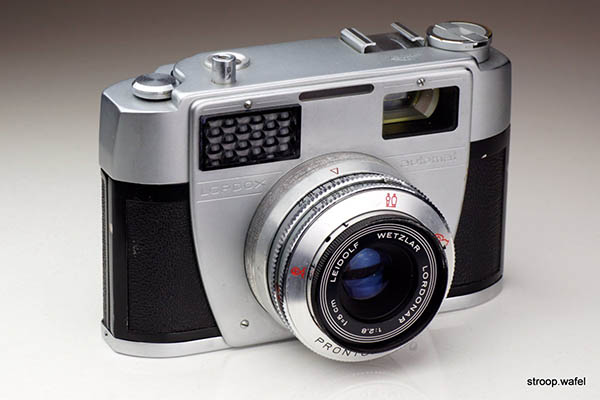
A Lordox Automat with Lordonar 50mm f/2.8 lens in Prontor-Matic shutter.
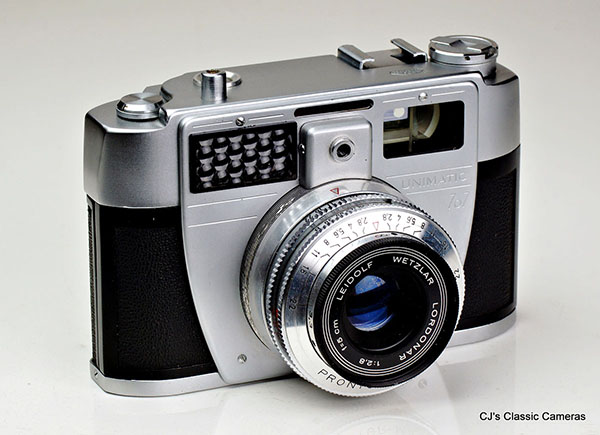
A Lordox Super Automat rebranded as Unimatic 707 with Lordonar 50mm f/2.8 lens in Prontor-Matic shutter. Note that this model had a depth of field scale on the shutter whereas the Automat above only has zone focus indicators.
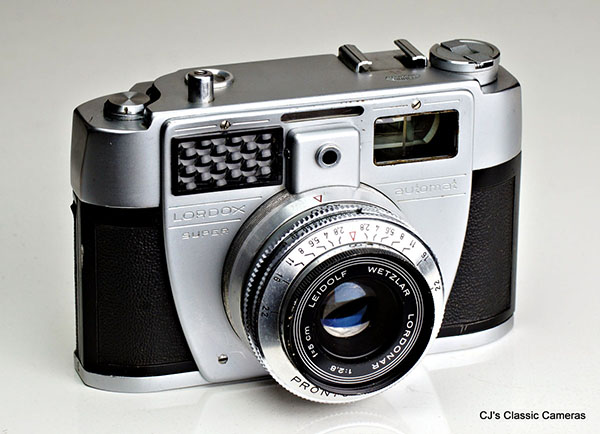
And here's the actual Leidolf version, the Lordox Super-Automat.
Lordox Blitz
The Lordox Blitz ('flash' in German) was Leidolf's contribution to the short-lived trend of putting a flash reflector on cameras to be used with small flash bulbs (see, e.g., the Kodak Retina IF and IIF and the Balda 300 BF). It was otherwise a fairly simple camera with a Triplon f/2.8 lens in a Pronto or Prontor-SVS shutter. It had a normal single stroke film advance like the Lordox Automat above, but did not have the restyled front plate. The battery needed for the flash was behind the 'Blitz' logo, which could be opened by pushing a small lever.
This camera was also sold, and nowadays more commonly found, as the Uni Blitz.
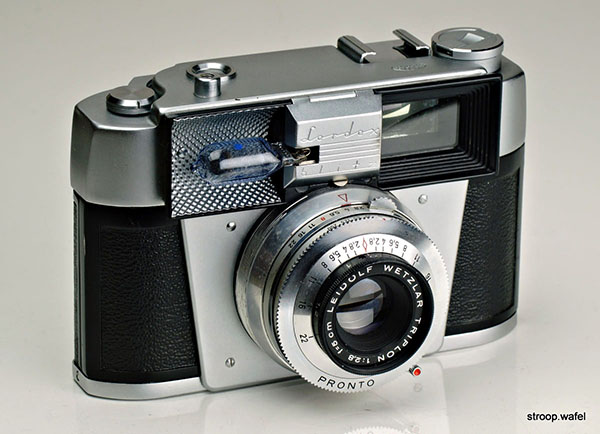
A Leidolf Lordox Blitz with Leidolf Triplon 50mm f/2.8 lens in Pronto shutter and a Philips AG3B flashbulb inserted in its socket. Move the mouse over the image to see the battery compartment.
Lordox BL
The 1961 Leidolf Lordox BL had a similar styling as the Lordox Automat shown above, but was a simpler camera as it had a non-coupled lightmeter and therefore a fully manual exposure system. It also had a cheaper three-element Triplon lens. It appears it wasn't a particular popular camera, as they're hard to find nowadays, and I doubt that's because collectors are sitting on them. Nevertheless, there are a few slightly different variants, one with a black lens ring like the one shown below, and one with a grey one. The lightmeter would indicate the light value which you then had to transfer manually to the aperture and shutter setting rings, but the light values scale was located at the bottom of the shutter, so it was all a little cumbersome.
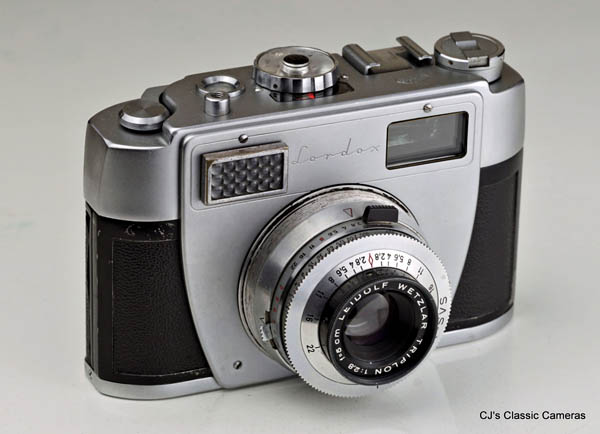
A Lordox BL with Triplon f/2.8 lens in Prontor-SVS shutter.
Lordomat SLE v.2
The Lordomat SLE v.2 was an updated version of the earlier Lordomat SLE shown above. The new version had the same style front plate as the Lordox Automat above. There were many improvements compared to the earlier Lordomat versions, such as a parallax corrected viewfinder that was coupled to the rangefinder mechanism, a normal single-stroke windlever, a frame counter with automatic reset to zero when the back was opened and a rewind, and a rewind knob with a pull-out lever. Thus, this was definitively the best Lordomat to use, but it turned out to be the last camera model Leidolf ever made.
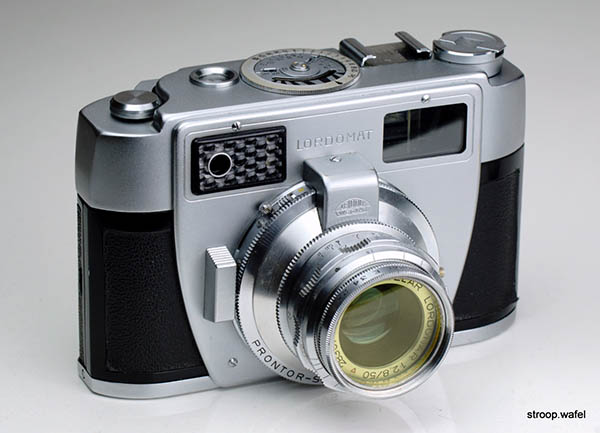
The second version of the Lordomat SLE with Lordonar lens in Prontor-SVS shutter.
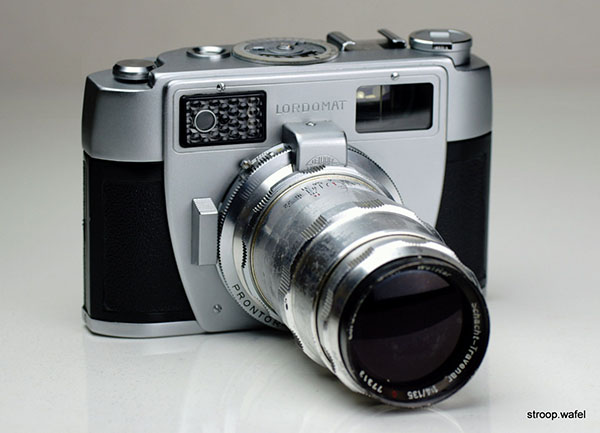
The same Lordomat SLE with a 135mm f/4 Schacht-Travenar lens mounted. A separate viewfinder was not required to use this lens, as 90mm and 135 frame lines were indicated in the viewfinder in addition to the standard lens frame.
| 
